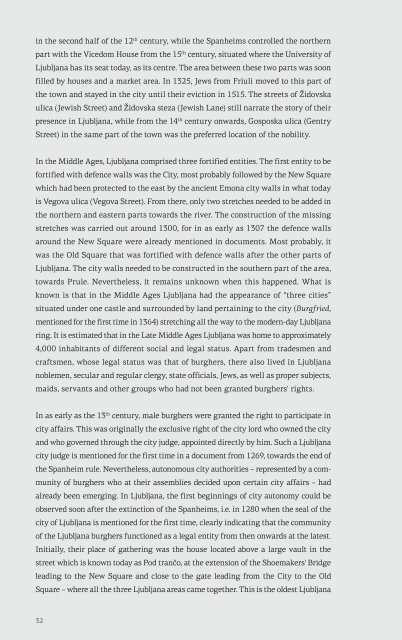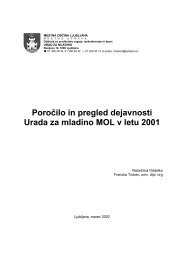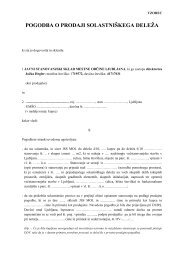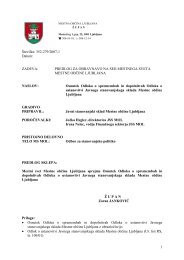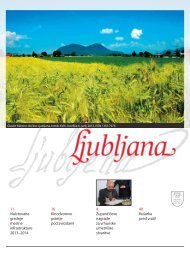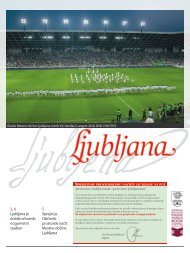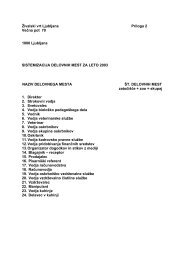Create successful ePaper yourself
Turn your PDF publications into a flip-book with our unique Google optimized e-Paper software.
in the second half of the 12 th century, while the Spanheims controlled the northernpart with the Vicedom House from the 15 th century, situated where the University of<strong>Ljubljana</strong> has its seat today, as its centre. The area between these two parts was soonfilled by houses and a market area. In 1325, Jews from Friuli moved to this part ofthe town and stayed in the city until their eviction in 1515. The streets of Židovskaulica (Jewish Street) and Židovska steza (Jewish Lane) still narrate the story of theirpresence in <strong>Ljubljana</strong>, while from the 14 th century onwards, Gosposka ulica (GentryStreet) in the same part of the town was the preferred location of the nobility.In the Middle Ages, <strong>Ljubljana</strong> comprised three fortified entities. The first entity to befortified with defence walls was the City, most probably followed by the New Squarewhich had been protected to the east by the ancient Emona city walls in what todayis Vegova ulica (Vegova Street). From there, only two stretches needed to be added inthe northern and eastern parts towards the river. The construction of the missingstretches was carried out around 1300, for in as early as 1307 the defence wallsaround the New Square were already mentioned in documents. Most probably, itwas the Old Square that was fortified with defence walls after the other parts of<strong>Ljubljana</strong>. The city walls needed to be constructed in the southern part of the area,towards Prule. Nevertheless, it remains unknown when this happened. What isknown is that in the Middle Ages <strong>Ljubljana</strong> had the appearance of “three cities”situated under one castle and surrounded by land pertaining to the city (Burgfried,mentioned for the first time in 1364) stretching all the way to the modern-day <strong>Ljubljana</strong>ring. It is estimated that in the Late Middle Ages <strong>Ljubljana</strong> was home to approximately4,000 inhabitants of different social and legal status. Apart from tradesmen andcraftsmen, whose legal status was that of burghers, there also lived in <strong>Ljubljana</strong>noblemen, secular and regular clergy, state officials, Jews, as well as proper subjects,maids, servants and other groups who had not been granted burghers' rights.In as early as the 13 th century, male burghers were granted the right to participate incity affairs. This was originally the exclusive right of the city lord who owned the cityand who governed through the city judge, appointed directly by him. Such a <strong>Ljubljana</strong>city judge is mentioned for the first time in a document from 1269, towards the end ofthe Spanheim rule. Nevertheless, autonomous city authorities – represented by a communityof burghers who at their assemblies decided upon certain city affairs – hadalready been emerging. In <strong>Ljubljana</strong>, the first beginnings of city autonomy could beobserved soon after the extinction of the Spanheims, i.e. in 1280 when the seal of thecity of <strong>Ljubljana</strong> is mentioned for the first time, clearly indicating that the communityof the <strong>Ljubljana</strong> burghers functioned as a legal entity from then onwards at the latest.Initially, their place of gathering was the house located above a large vault in thestreet which is known today as Pod trančo, at the extension of the Shoemakers' Bridgeleading to the New Square and close to the gate leading from the City to the OldSquare – where all the three <strong>Ljubljana</strong> areas came together. This is the oldest <strong>Ljubljana</strong>Town Hall referred to in 1406 as kamawn, commune. When a new City Hall was builtin 1484 in the Town Square, the Old Town Hall was turned into a town prison.In the 14 th century, the commune, a general assembly of all the citizens, evolvedinto a 12-member (internal) City Council which in time became the most importantbody of autonomous town authorities and gave name to “Rotovž” (from Rathaus,the Council House). At a later stage, a further 24-member external City Councilwas established as a type of supervisory body. One of the peculiarities influencingthe life in medieval <strong>Ljubljana</strong> was that, around the turn of the 14th century, thecity lord was simultanously represented by several judges. However, as soon as theHabsburgs took over the rule over Carniola and <strong>Ljubljana</strong> in 1335, the city only hadone city judge. More importantly, from the middle of the 14 th century onwards, thecity judge was elected by the city commune and was no longer appointed by thecity lord. This happened exceptionally early in comparison with the other citiesunder the Habsburg rule. Still, because of the elections of the city judge there wasno need for a representative of local self-governement, i.e. the mayor. This is thereason why, throughout the Middle Ages, <strong>Ljubljana</strong> never had a mayor. The firstmayor of <strong>Ljubljana</strong> was only elected in 1504, out of prestige rather than out of need.With the privilege granted by the then city lord, King Maximilian I, the <strong>Ljubljana</strong>city judge and the City Council were granted the right “to annually elect from theirmidst a mayor who shall be an able, capable and honourable person”.This was the time when <strong>Ljubljana</strong> already fully functioned as the capital city ofCarniola as has also been mentioned in a 1442 document (Laybach...hauptstatdaselbst in Krain). The castle which originally represented the centre of the <strong>Ljubljana</strong>seigneury and the (occasional) residence of the city lord slowly became the centreof the land authorities of Carniola where governors as the deputies and representativesof the duke performed their duties as revealed by their coats of arms in the castleChapel of St. George with frescoes dating back to the 18 th century. <strong>Ljubljana</strong> wasalso the residence of the Land Vicedom managing the duke's property, as well as ofall the state officials headed by the governor. In the New Square, where the SloveneAcademy of Sciences and Arts is located today, there also was “Lontovž” (fromLandhaus, the Land House) – the House of Estates. Their hereditary oaths to theDuke of Carniola obviously took place in <strong>Ljubljana</strong>, where also the court competentfor the Carniolan nobility had its seat. In 1461 or 1462, <strong>Ljubljana</strong> became the seatof a bishop, with the Church of St. Nicolas, mentioned for the first time in a 1262 document,as its cathedral. Apart from the German Knight Order in Križanke, <strong>Ljubljana</strong>also boasted a Franciscan (Minorate) monastry in the Vodnik Square (first mentionedin 1242) and an Augustine monastry (located outside the city walls in thePrešeren Square, mentioned for the first time in 1314). With the establishment ofa diocese, even before the end of the Middle Ages, <strong>Ljubljana</strong> became the religiouscentre of a geographical area much larger than the land of Carniola.3233


